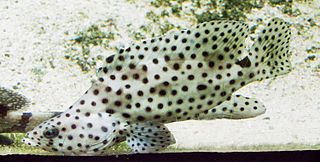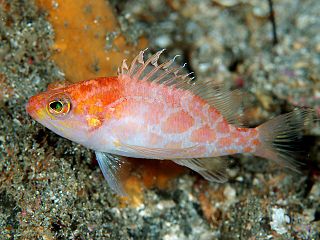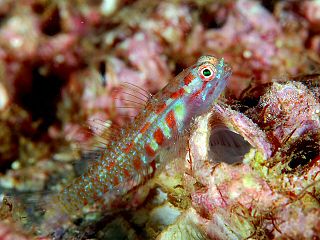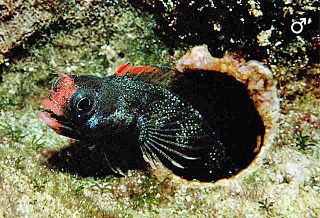
Serranidae is a large family of fishes belonging to the order Perciformes. The family contains about 450 species in 65 genera, including the sea basses and the groupers. Although many species are small, in some cases less than 10 cm (3.9 in), the giant grouper is one of the largest bony fishes in the world, growing to 2.7 m in length and 400 kg (880 lb) in weight. Representatives of this group live in tropical and subtropical seas worldwide.

Opistognathidae, the jawfishes, are a family of fishes which have been classified within the order Perciformes, suborder Percoidei but many authorities now classify this family within the clade Ovalentaria and consider that its affinities within that clade are uncertain, i.e. it is incertae sedis. The family includes about 80 species. They are native to warmer parts of the Atlantic, Pacific and Indian Oceans, where found from the shallows to depths of a few hundred meters. The species level taxonomy is complex and the family includes several undescribed species.

Pompanos are marine fish in the genus Trachinotus in the family Carangidae. Pompano may also refer to various other, similarly shaped members of the Carangidae, or the order Perciformes. Their appearance is of deep-bodied fishes, exhibiting strong lateral compression, with a rounded face and pronounced curve to the anterior portion of their dorsal profile. Their ventral profile is noticeably less curved by comparison, while their anterior profile is straight-edged, tapering sharply to a narrow caudal peduncle. Their dorsal and anal fins are typically sickle-shaped, with very long anterior rays and a succession of much shorter rays behind, with a similarly long & curved, deeply forked tail which has a narrow base. They are typically overall silvery in color, sometimes with dark or yellowish fins, and one or a few black markings on the side of their body. They are toothless and are relatively large fish, up to about 1.2 m (3.9 ft) long, although most species reach no more than half or two-thirds of that size. They are found worldwide in warmer seas, sometimes also entering brackish waters.

Anthias are members of the family Serranidae and make up the subfamily Anthiinae. The name Anthiidae is preoccupied by a subfamily of ground beetles in the family Carabidae created by Bonelli in 1813 and this grouping should be called the Anthiadinae. However, both the 5th Edition of Fishes of the World and FishBase give the Serranid subfamily as "Anthiinae".

Chromis is a genus of fish in the family Pomacentridae. While the term damselfish describes a group of marine fish including more than one genus, Chromis is the largest genus of damselfishes. Certain species within the genus are common in the aquarium trade.

Pomacentrus is a genus of marine damselfish in the family Pomacentridae. These fish inhabit tropical locations and are often captured or bred as aquarium fish.

Gymnothorax is a genus of fish in the family Muraenidae found in Atlantic, Indian, and Pacific Oceans. With more than 120 species, it the most speciose genus of moray eels.

Apogon is a large genus of fish in the family Apogonidae, the cardinalfishes. They are among the most common fish on coral reefs. Over 200 species have been classified in genus Apogon as members of several subgenera. Some of these subgenera, such as Ostorhinchus, have been elevated to genus status, leaving just over 50 species in the genus.

Scorpaenodes is a widespread genus of marine ray-finned fish belonging to the family Scorpaenidae, the scorpionfishes. The fishes in this genus are found to the Atlantic, Indian and Pacific Ocean.

Plectranthias is a genus of ray-finned fish in the subfamily Anthiinae, part of the family Serranidae, the groupers and sea basses. They are found in the Atlantic, Indian and Pacific Ocean.

Eviota is a genus of fish in the family Gobiidae, commonly as dwarfgobies found in the Indo-Pacific region, where it is distributed from Japan to Australia and from Africa to Pitcairn Island. Species are mainly associated with coral reefs. Many of these fish are short-lived, with life cycles as brief as 3.5 weeks in the tropics. Some species are hermaphrodites and some representatives live symbiotically among the tentacles of the mushroom coral.

Halichoeres are a genus of wrasses found in the Atlantic, Indian and Pacific Oceans.
The dusky jawfish is a species of jawfish native to the western Atlantic Ocean including the Gulf of Mexico and the Caribbean Sea where it is an inhabitant of reefs at depths of from 1 to 12 metres. It can reach a length of 14 centimetres (5.5 in) TL. This species can also be found in the aquarium trade.

Acanthemblemaria is a genus of chaenopsid blennies native to the Atlantic and Pacific Oceans.
Chasmodes longimaxilla, the stretchjaw blenny or longjaw blenny, is a species of combtooth blenny found in the western central Atlantic ocean.
Hypleurochilus caudovittatus, the zebratail blenny, is a species of combtooth blenny found in the western central Atlantic ocean, in the Gulf of Mexico off the western coast of Florida.
Hypleurochilus multifilis, the featherduster blenny, is a species of combtooth blenny found in the western Atlantic ocean, in the Gulf of Mexico around Texas, USA. Its distribution extends from central Florida to Tabasco, Mexico.
Lupinoblennius nicholsi, the highfin blenny, is a species of combtooth blenny found in the western Atlantic ocean, on the coasts of the Gulf of Mexico in north-eastern Mexico and Texas, it has also been recorded from Englewood, Florida. This species reaches a length of 6 centimetres (2.4 in) TL. The specific name honours the American ichthyologist John Treadwell Nichols (1883-1958).

Stalix is a genus of jawfishes native to the Indian Ocean and the western Pacific Ocean.

Liopropoma is a genus of marine ray-finned fish, related to the groupers and included in the subfamily Epinephelinae, part of the family Serranidae, which also includes the anthias and sea basses. They are sometimes seen in the marine aquarium trade.
















